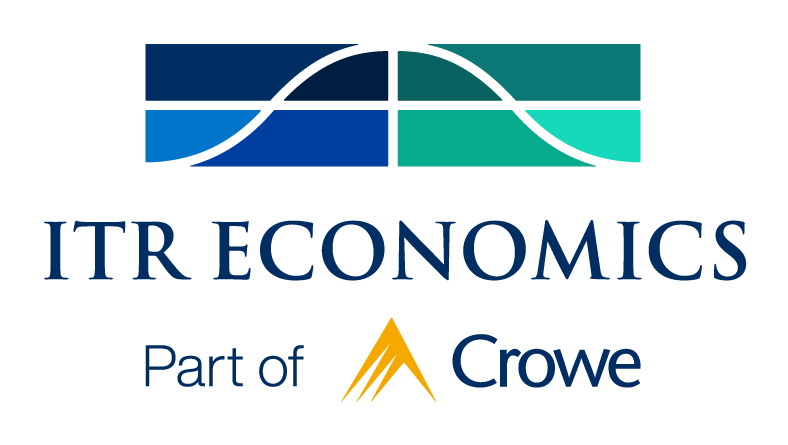July 21, 2023
- Home
- portfolio
- TrendsTalk
- July 21, 2023
CANADA'S ECONOMY AND CONSUMERS
Tune in to a new episode of TrendsTalk as ITR Economist Taylor St. Germain highlights the current state of Canada’s economy, as well as the strength of Canadian consumers.
The below transcript is a literal translation of the podcast audio that has been machine generated by Rev.
Taylor St. Germain:
Hi, everyone. My name’s Taylor St. Germain. I’m an economist with ITR Economics, and welcome to this episode of Trends Talk. Last week we discussed the U.S. consumer, the state of the U.S. consumer, and what it meant for our mild recession coming in 2024. Today, I wanted to discuss similar trends, but talk about our neighbors to the north, our friends to the north, Canada, take a look at how Canada’s economy is faring in terms of how well the consumer is performing and our expectations for Canada moving forward.
So to begin here, we do expect that in conjunction with the U.S. economy, we see Canada’s economy slowing down as we progress deeper into 2023, culminating in a mild recession in 2024. That’s our outlook for Canada industrial production, which is one of our trends report series. Now that’s very similar to the U.S. perspective, and it’s because when we look at Canada’s economy, Canada’s business cycle for Canada industrial production, it has a very high correlation with U.S. industrial production. They almost move in lockstep with one another. The U.S. exports a significant number of goods across the border to Canada, and so we have these close ties and close links, and as a result, you see the business cycles between the U.S. and Canada looking very similar. We also look at similar leading indicators, indicators of recession when we look at Canada and the U.S.
If you’ve been listening to our CEO’s Fed Watch videos on a weekly basis, you’ve probably heard a lot about the yield curve inversion here in the U.S. Well Canada has an inverted yield curve, as well. When we look at the yield curve, we like to focus on the 10-year government bond yield to the three-month government bond yield. We look at that for the U.S., and that’s what I’m looking at right now for Canada. And similar to the U.S., you see that yield curve inversion. What do I mean? The three-month yield is above the 10-year yield. That’s a indicator that with a high probability suggests that a recession is coming out in the future. So similar trends between the U.S. and Canada there, and Canada’s yield curve does suggest that we’re headed for a mild recession as we progress into 2024.
Now I talked a lot about the U.S. consumer last week, as well. Let’s talk about Canada’s consumer. There’s some trends that I wanted to call out as it relates to consumers in Canada that highlight and support this expectation of a mild recession as we move late this year and into 2024. The first metric that I’d like to call out is Canada household income. That had been rising for quite a while coming out of the pandemic in Canada, this metric; however, we’ve seen that metric stall out lately. I’m talking Canada household income, and I’m looking at an inflation-adjusted household income dataset. So we’re really removing those impacts of inflation, looking at what we economists call real incomes, and we can see that those have stalled out in Canada, and that’s indicative of some of the pressures that the Canadians are feeling as it relates to some of the higher interest rates and the central banks’ battle with some of these higher levels of inflation.
Now last week you also heard me call out a few delinquency rates as it related to the consumer, specifically auto, credit card, and mortgage delinquencies, and we talked about the resiliency of the U.S. consumer. I now wanted to call out those same metrics, but this time, again, looking at Canada. And what we can see is that from a credit card and mortgage delinquency perspective, Canada’s consumer is resilient. They’re displaying that resilience in the data because we see such low delinquency rates compared to the historical average. So mortgage delinquency rates in Canada, for example, 0.15%, that’s low. The historical average is 2.250%. So again, the consumer, very resilient in terms of the strength of the housing market when we look at Canada from a delinquency perspective. We’re paying our mortgages there in Canada.
Same thing with credit cards. Credit card long-run delinquency average about 1.4%. That’s exactly where the current data is at. So nothing overly concerning there as we think about previous recessions in Canada. Is this 2008, 2009 all over again in Canada? No. We can see that the consumer is quite resilient and strong, which is important for that Canadian economy.
Now the last metric I want to call out, this is the one that was a little bit different from the U.S. and that’s auto loan delinquencies. Auto loan delinquencies in the U.S., again, recalling our conversation last week, were very low. However, in Canada, that metric in particular is a bit more concerning to me. The reason for that is that we see the current monthly figure for auto loan delinquency rates in Canada at 2.11%, when the five-year average over the last five years was really 1.83%. So that’s a little bit more concerning in terms of some of the pressure that the consumer’s facing. But all in all, Canada has quite a resilient consumer, as well. It feeds into our expectation that like the U.S., Canada’s recession will be mild next year.
Again, please check out our trends report for more information on our forecast as it relates to Canada. I hope you found this information helpful. Thanks for joining me on this episode of Trends Talk, and we’ll see you on the next one.




